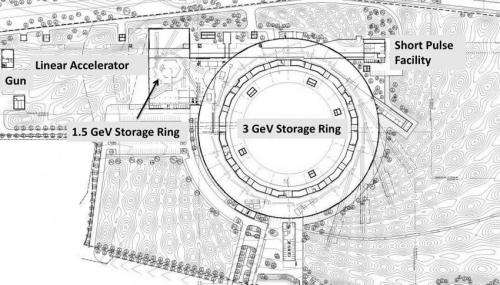A new generation of storage—ring

A bright synchrotron source that emits over a wide part of the electromagnetic spectrum from the infrared to hard X-rays is currently being built in Lund, Sweden. The MAX IV facility presents a range of technical challenges for the team putting together its component parts in a storage - ring synchrotron system that will have a circumference of just a few hundred metres. Nevertheless, if these various challenges can be addressed then an entirely new class of experiments that require source brightness and transverse coherence will be possible.
Pedro Tavares and colleagues of Lund University provide details of the obstacles they face. The facility has two electron storage rings that operate at 3 and 1.5 GeV, which Tavares explains are optimized for the hard X-ray and soft X-ray/vacuum ultraviolet spectral ranges, respectively. A linear accelerator, which also operates at 3 GeV, injects into both rings but can also drive X-ray pulses as short as 100 fs.
To confine the total circumference to just 528 m, the 3 GeV ring employs a multibend achromat (MBA) lattice. It is this design feature that gives rise to many of the technical issues that the team hopes to address. First, it needs a large number of magnets per achromat and these need to be compact yet powerful. Secondly, the design leads to small - aperture vacuum chambers that result in low vacuum conductance and the need for distributed pumping as well as for the distributed absorption of heat deposited by the synchrotron radiation. There is also a requirement to accommodate a low main radio frequency (100 MHz) and to lengthen the electron bunches to alleviate multiple scattering within the bunches as well as to avoid collective effects driven by, amongst other effects, the chamber wall resistivity.
The team details solutions to the various problems with regard to the MAX IV 3 GeV ring and presents its lattice design as well as the engineering approaches that will overcome the technical issues. "As the first realisation of a light source based on the MBA concept, the MAX IV 3 GeV ring offers an opportunity for validation of concepts that are likely to be essential ingredients of future diffraction-limited light sources," the team concludes. "Regarding the next steps in the MAX IV Project, we are currently involved with the installation of the 3 GeV ring, and commissioning is planned to start mid - 2015," Tavares told us.
The Tavares paper forms part of the special issue in the Journal of Synchrotron Radiation: Diffraction - Limited Storage Rings and New Science Opportunities.
More information: Tavares et al. (2014). J. Synchrotron Rad. 21, 862-877; DOI: 10.1107/S1600577514011503
Provided by International Union of Crystallography



















